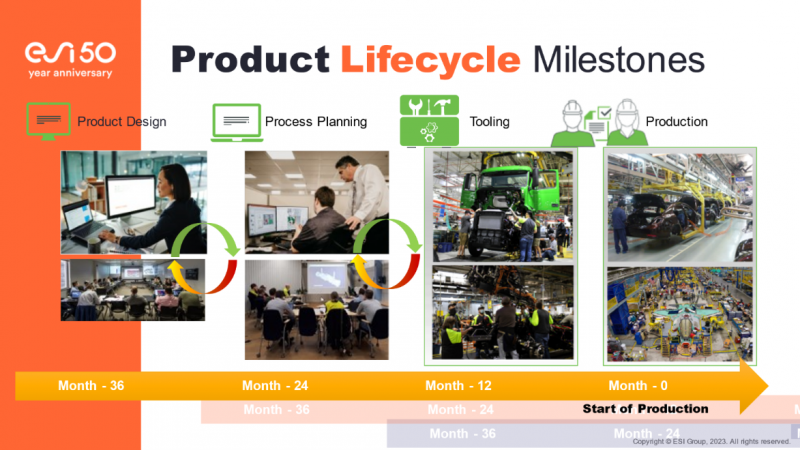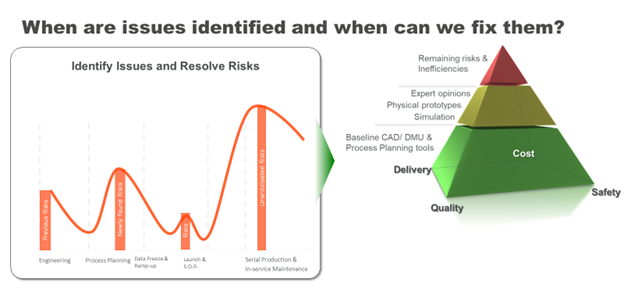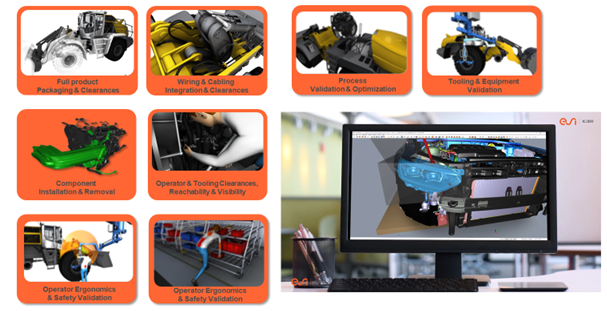Weaving Continuity into Enterprise Digital Threads
Replacing the physical with the digital: Solving the challenge by connecting the digital thread

Defining Digital Thread 'Skipped Stitches' and Using VR to Address Them
The journey toward the “Industrial Metaverse” for digitally transformed enterprises is filled with potential wrong turns and turbulence. As physical processes are displaced by virtual or digital processes, new challenges for manufacturers emerge. Digital substitutions for historical physical processes could miss aspects of the product development process that were beneficial without being necessarily mandated.
Consider for example, the previous use of physical prototypes or mock-ups during product engineering. It is obvious that back then people had to reach, access, and install things to construct the prototype they used in product engineering. Anytime a proposed design could not be built by a human, they would stop to design something that they could build to make a test version. Therefore, it was unlikely that defined engineering specifications had explicitly required the validation that human operators could feasibly assemble that product in order to prove/disprove a design.
When test pilots flew prototype aircraft, ground crews certainly noticed if components were too difficult to install, access, or replace without it being part of the test specification—necessary changes would be requested and if the product could not be built, the test would not proceed. The risk is that today, in the digital design and testing space, we draw those objects in their final part position. But have we adequately considered how a component arrives at that location, or how to remove it later if, or when, it fails?
This leaves a risk of gaps, or figuratively “skipped stitches”, in an enterprise digital thread.
This reduced reliance on physical prototyping in modern product development timelines deprives enterprises of practical milestones where they previously discovered that people might have issues building, maintaining, or operating the proposed new products. To address that risk, our subscribers use VR or XR experiences to virtually build and virtually disassemble product designs in fully immersive and physically realistic virtuality.
When in that virtual assembly line or extended reality maintenance hangar, the user in VR is effectively transcending time and space to experience how they interact with the new products in proposed human-performed tasks or processes—human-centric process and product validation.
Human-Centric Process Validation or Time Travel
Conventional “proof” that a person can safely perform an assembly, service, or other human-centric process tasks is not really obtained until real people experience the real product in a real assembly line environment. In the past, this was not a major issue because building physical prototypes and performing assembly and disassembly of physical objects was a common part of every product development timeline; the first-of-its-kind product would be built up as part of the design project. However, the industry has already reduced the number of physical builds and replaced them with digital engineering reviews. Product development timelines have been reduced in planned length as a result.
However, feedback from some OEMs still indicates that the reduction of physical experience with a product in context has resulted in significant numbers of engineering design issues emerging (first being observed) at SOP. When such issues emerge late, there is little chance to cost-effectively mitigate the issue without delaying the product launch or having to live with the issue until engineering changes can be approved.
To this end, ESI Group has been providing our subscribers with powerful tools in IC.IDO enables them to experience the products of tomorrow, today, without having to wait for or invest in physical prototypes, construct mock-ups, or force people to travel to pilot halls or transport pre-production hardware. Rather, ESI IC.IDO creates opportunities for people to experience how they would interact with products in the context of proposed manufacturing processes or maintenance procedures.
The Value of Human-Centric Validation
With ESI IC.IDO, enterprise subscribers take their digital product designs and create immersive experiences for their stakeholders to participate first-hand in the processes that humans would commonly perform in, and around, their new products.
Valuable outcomes, or validations, that emerge from human-centric process reviews include:
- product packaging and clearances, static & dynamic
- wiring, cabling, and hose routing and clearances
- component installation and removal
- operator visibility, reachability, and accessibility
- process validation and optimization
- tooling and equipment validation
- operator ergonomics and safety
- workcell and line optimization
More than just enabling immersive visualization and exploring new product designs in true-to-life scale, IC.IDO aims to involve stakeholders in the processes that people will be expected to interact in with the products.
An Engaging Experience with IC.IDO
The conclusions reached when real people experience for themselves an assembly or maintenance process, are potentially very different than conclusions reached after watching a 30-second-long video or digital animation on-screen. Whenever a stakeholder can experience for themselves a new product in the context of the procedures intended to produce it, or methods proposed to maintain it, that product benefits. If we can accelerate the timing of experience-based reviews through the application of eXtended or Virtual Reality, we stand to further reduce the risk in taking new and novel products to market.
Virtual builds, powered by IC.IDO has enabled our enterprise subscribers to augment their engineering workflows with digital experiences they might not otherwise have access to without constructing physical mock-ups or prototypes.
Further questions still emerge, and risk drop stitches along our digital threads:
How can we engage the experiences of multiple stakeholders and distributed teams?
How do we capture and communicate findings from virtual builds for integration into engineering?
Addressing these following questions, once we recognize the value in applying Virtual and extended Reality to the evaluation of required human-conducted processes, justifies further discussion and additional blog posts. These, and other questions, will be addressed with upcoming blog posts which will be published here soon, stay tuned for more.
You can learn more on our IC.IDO webpage.
Eric Kam is the Marketing and Alliances Director for ESI Group’s Manufacturing Business Channel, supporting their Immersive Experience (VR/AR/MR/xR) Solutions and Virtual Manufacturing Suite. He is an outspoken advocate for the ongoing transformation in Computer Aided Design, Finite Element Analysis, and Computer Aided Engineering. He has spent the bulk of the last 25 years promoting the democratization of previously “analyst-driven” technologies to bring the benefits of Virtual Engineering tools to the engineering and manufacturing practitioners themselves.


